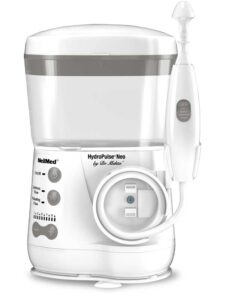Empty Nose Syndrome
ENS Diagnosis
Patients with Empty Nose Syndrome have a special problem. When they tell the doctor that they have trouble getting enough air. When she looks in the nose and sees that the airway is wide open, she may conclude that there is simply nothing wrong with this patient, or worse, prescribe a nasal corticosteroid which can make the symptoms worse.
ENS is Life Altering
Empty Nose Syndrome (ENS) is a devastating problem and can be life altering. Symptoms can include a sensation of not getting enough air, nasal pain, loss of olfactory sense, frequent sinus infections, headaches, poor sleep, fatigue, unpleasant dryness and crusting. There is frequent nasal pain. Yet, the blood oxygen measures normal.
Today’s treatment includes using a Ringer’s type saline without preservatives, and special ointments to build up tissues. Hydro Pulse™ pulsating irrigation acts as a replacement to the absent nasal cilia defense.
Surgical Correction: Steve Houser
In 2000, at the Academy of Otolaryngology, Dr Steve Houser and I presented a program on this topic, called Mucociliary Clearance. Surgical correction for ENS has been described by doctor Houser since then, but up to now, there hasn’t been large studies that measured symptom relief.
An article just published in the JAMA – Otolaryngology Journal, May 2014, reports on a group of patients diagnosed ENS who had MedPor implant surgery. They reported on symptoms of fatigue, reduced concentration, sadness, dryness and nose too open, in addition to the standard nasal airway complaints. After the implant surgery, these patients reported that their ENS symptoms were reduced.
Use of MedPor implants for absent tissue is one of the subjects that Dr Nicholas Schenck has published on. This product has many uses for replacing absent tissue; not just in ENS.
Why Implant for ENS:
In ENS, the nasal passages are far too wide. There may have been surgical removal of the inferior turbinates. The purpose of the inferior turbinate is to direct the air flow, warm the air, moisten and filter the air.
When the inferior turbinate is absent, air is misdirected, isn’t moistened on its way to the lungs, and isn’t warmed.
When the MedPor is inserted, new channels are created through the product itself. These new blood vessels insure that the implant remains viable. Doctor Schenck places the implant so it is positioned best to imitate the missing turbinate tissue.
With this correction, the air flow goes to the sensors that tell the brain that the air is coming in properly. The incoming air gets warmed too. What is most important, as shown by the JAMA study, is that the majority of patients report a significant improvement of their symptoms.
Medical Management of ENS
Fortunately, many ENS patients respond to the Tower ENT program for Empty Nose Syndrome
Ringer’s type saline such as Breathe.ease Xl. This is saline without any preservative.
Topical ointments to generate tissue and reduce bacteria
Pulse rate irrigation to “replace” the absent cilia; the Hydro Pulse™ Nasal/Sinus Irrigator
Various solutions added to the Hydro Pulse™ to lower bacteria count, allowing for natural healing.
If an antibiotic is required, it can be added to the Hydro Pulse solution.
These products are discussed in detail at www.grossaninstitute.com
Avoid Preservatives and Cortisone Sprays
ENS patients are particularly sensitive to various preservatives used for saline solutions. With Breathe.ease XL the solution is made fresh without benzalkonium preservative
ENS patients should not use Corticosteroid sprays, because these tend to thin the membranes.
To avoid becoming an ENS patient, always inquire about non-surgical solutions to nasal problems; discuss the possibility of removal of nasal turbinates. Often, restoring nasal cilia defense can solve many chronic sinusitis problems.
The symptoms of Empty Nose Syndrome can be quite unpleasant The recent published study showing significant improvement in ENS symptoms following MedPor implant is welcome news for all.

